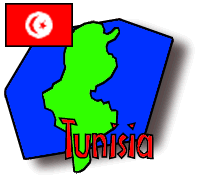\
BikeAbout Trip Log: October 30, 1997
topics: Emperor Gordian I, Roman Amphitheater; jump to dispatch
BikeAbout Log

Rider Notes: October 30, 1997
Breakfast: On the way out of Kairouan, we stopped at a small grocery store to stock up on cookies and bread.
Lunch: After the visit to the Roman Amphitheater in El Jem, the boys picked up some take-out, individually sized pizzas — one tuna and one cheese — while the girls found veggie sandwiches.
Dinner: With Ethan away attending a meeting in Sousse, and the ladies still full from their late lunch, Anthony and Padraic returned to the pizza place, but this time ordered a full meal of roast chicken, french fries, and salad.
Food of the Day: Tuna
Tunisians seem to stick tuna in everything — salads, briks, pizza, omelets, sandwiches, crêpes, etc. It turns out that this has almost always been the case. Since the time of the ancient Phoenicians, who founded Carthage over 2,500 years ago, the people of the Mediterranean have relied on tuna as an important part of their diet. Ancient Greek fishermen used sophisticated methods of tracking migrating schools of tuna. Many of these same methods were still in use as late as the 19th century. Although seldom eaten fresh — most of what we've had is like the canned variety we're used to from home — tuna remains Tunisia's most favored fish.
Person of the Day: Emperor Gordian I
Between 235 and 268 AD, a series of harsh military dictators ruled the Roman Empire. The heavy-handed policies of the first of these, Emperor Maximinus, sparked a revolt in the Roman province of North Africa. Angered by the heavy taxes demanded by the Emperor and ruined by a recent drop in olive oil prices, the natives of Thysdrus (modern day El Jem) took action. During a festival held in their giant amphitheater (see the Place of the Day), the rebels proclaimed Gordian I, the aged proconsul of North Africa (the Roman equivalent of the governor of an American state), the new Emperor of Rome. Gordian had won popularity for his enthusiastic sponsorship of sport — indeed, he was probably the man most responsible for building the amphitheater in Thysdrus.
Unfortunately for Gordian, he mistook this popularity for military strength and accepted the title of Emperor. His ambitions brought only tragedy. Forces loyal to Emperor Maximinus soon defeated Gordian's troops in battle, ransacking Thysdrus and killing Gordian's son in the process. Soon thereafter, Gordian himself committed suicide in his villa in Carthage. Despite his sorry end, the fact that Gordian helped to build, and then was proclaimed Emperor in, the very spot we visited today (some 1750 years later), makes Gordian our person of the day.
Place of the Day: Roman Amphitheater 

The Roman Amphitheatre ("amphitheater" means "circular theater" in Latin) at El Jem is the last of our Tunisian UNESCO World Heritage sites.  Built in the third Century AD, the amphitheater is considered the most impressive Roman structure in the whole of North Africa. The fourth largest amphitheater in the Roman world (can anyone tell us which three are bigger? here's a hint about one of them), its oval shape and large scale (150 m/164 yd by 124 m/136 yd and over 457 m/500 yd in diameter with room for 35,000 spectators) make it not unlike some sports stadiums we are familiar with today. This enormous structure testifies to the technical skill of the Roman architects and builders, as well as to the splendor of the Roman Empire during its heyday. (For more on the amphitheater at El Jem, read below.)
Built in the third Century AD, the amphitheater is considered the most impressive Roman structure in the whole of North Africa. The fourth largest amphitheater in the Roman world (can anyone tell us which three are bigger? here's a hint about one of them), its oval shape and large scale (150 m/164 yd by 124 m/136 yd and over 457 m/500 yd in diameter with room for 35,000 spectators) make it not unlike some sports stadiums we are familiar with today. This enormous structure testifies to the technical skill of the Roman architects and builders, as well as to the splendor of the Roman Empire during its heyday. (For more on the amphitheater at El Jem, read below.) 


Group Dispatch, October 30

For the first time since we arrived in Tunisia, we woke to find the weather overcast and chilly. This certainly didn't make it any easier to drag ourselves out of bed. Especially since by the time we had loaded our bikes, it had begin to rain. Once we took off, however, we realized that the change in weather had brought a welcome shift in wind direction. Instead of the headwind that had been blowing at us for a number of days, it was now at our backs as we sped along to El Jem. The strong tailwinds took our minds off the wet weather and pushed us into town in plenty of time to make our scheduled stop for the day: a visit to the colossal Roman amphitheater (see the Place of the Day).
We had no problem finding the amphitheater. In fact, we spotted it from about four km (2.5 mi) outside of El Jem. Its ochre sandstone arches  towered over the rest of the white buildings of town. Our immediate reaction was to ask what was such an enormous building doing in such a quiet little town. The answer is that sleepy El Jem hasn't always been El Jem. During the Roman era it was a prosperous city called Thysdrus. A market center (surrounded by wealthy merchants' villas) that owed its success to the vast olive groves that surrounded it, Thysdrus was dubbed by some historians as the "oil capital" (olive oil that is) of the Roman Empire.
By the early third Century AD, when the amphitheater was built, Thysdrus rivaled Hadrumet (today called Sousse) as the second city of Roman North Africa. However, following the revolt that began there in 238 AD (read more about this in the Person of the Day), Roman troops loyal to the Emperor Maximinus destroyed the city. It never really recovered.
Although the town declined, the amphitheater remained. Despite the pillaging of some of its massive stones for other buildings (including the Great Mosque in Kairouan), and the 19th century destruction of a portion of the walls (to flush out another generation of rebels who had taken refuge in the great building), the amphitheater's remains are remarkably intact.
towered over the rest of the white buildings of town. Our immediate reaction was to ask what was such an enormous building doing in such a quiet little town. The answer is that sleepy El Jem hasn't always been El Jem. During the Roman era it was a prosperous city called Thysdrus. A market center (surrounded by wealthy merchants' villas) that owed its success to the vast olive groves that surrounded it, Thysdrus was dubbed by some historians as the "oil capital" (olive oil that is) of the Roman Empire.
By the early third Century AD, when the amphitheater was built, Thysdrus rivaled Hadrumet (today called Sousse) as the second city of Roman North Africa. However, following the revolt that began there in 238 AD (read more about this in the Person of the Day), Roman troops loyal to the Emperor Maximinus destroyed the city. It never really recovered.
Although the town declined, the amphitheater remained. Despite the pillaging of some of its massive stones for other buildings (including the Great Mosque in Kairouan), and the 19th century destruction of a portion of the walls (to flush out another generation of rebels who had taken refuge in the great building), the amphitheater's remains are remarkably intact. 
 After dropping off our luggage and bikes, we spent hours exploring the amphitheater from top to bottom.
After dropping off our luggage and bikes, we spent hours exploring the amphitheater from top to bottom. 
 Trying to get into the spirit of the occasion, Anthony and Ethan squared off in a mock gladiatorial contest (with bike pumps instead of swords) while the rest of the group cheered them on from the front row of seats. The only losers were the bike pumps. (Note to loyal readers: Please send bike pumps!) andrEa consented to be thrown to the lions and leapt bravely into the middle of a German tour group.
Afterwards we climbed to the top tier of seats and enjoyed a great panorama of the town and the surrounding olive groves. We also got a very good idea what the view from the "cheap seats" must have been like. Finally, we explored the spooky bottom level of the amphitheater, below the ground floor, where we imagined the lions, gladiators, and chariots waited for their turns to entertain the crowds.
Unfortunately, just as we climbed back up to the ground floor, the rains began again, chasing us back to the warmth and comfort of our hotel room (from which we could still see the amphitheater). We all agreed that this was one of the most impressive ancient sites we had ever seen.
Trying to get into the spirit of the occasion, Anthony and Ethan squared off in a mock gladiatorial contest (with bike pumps instead of swords) while the rest of the group cheered them on from the front row of seats. The only losers were the bike pumps. (Note to loyal readers: Please send bike pumps!) andrEa consented to be thrown to the lions and leapt bravely into the middle of a German tour group.
Afterwards we climbed to the top tier of seats and enjoyed a great panorama of the town and the surrounding olive groves. We also got a very good idea what the view from the "cheap seats" must have been like. Finally, we explored the spooky bottom level of the amphitheater, below the ground floor, where we imagined the lions, gladiators, and chariots waited for their turns to entertain the crowds.
Unfortunately, just as we climbed back up to the ground floor, the rains began again, chasing us back to the warmth and comfort of our hotel room (from which we could still see the amphitheater). We all agreed that this was one of the most impressive ancient sites we had ever seen.
Questions? Ask Padraic  !
!



Copyright 1997-2004 BikeAbout. All rights reserved.
![]()
![]()

![]() !
!




